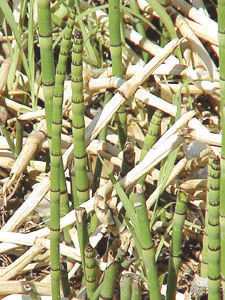Master Gardener: Galloping horsetail threatens gardeners
Published 5:00 pm Tuesday, April 26, 2005

- Photo North Carolina State UniversityHorsetail is among the worst of the plants that infest gardens.
QUESTION: We just purchased a new place and have discovered that there is horsetail starting to come up in several of our flower beds. What is the best way to get rid of it?
ANSWER: Of all of the weeds that infest home gardens, horsetail is among the worst. Conventional weed control methods of hand pulling, cultivation or the use of commonly used garden weed killers like 2,4-D or Roundup simply are not effective due to the high level of food reserves stored in the rhizome. Years ago research conducted by weed scientists at Washington State University found an almost impermeable barrier of horsetail roots six feet below a well-established infestation. During the Carboniferous age (more than 230 million years ago), the Horsetail family was the dominant plant group in the world, with plants reaching gigantic size.
Because the stems may become encrusted with minute particles of transparent silica, these plants are often referred to as “scouring rushes.” The name arose from the use of these plants by the pioneers as a scouring agent for pots and pans. They are also reported to be equivalent to the finest grades of steel wool in polishing wood finishes and were formerly standard items with European cabinetmakers.
Horsetail is poisonous to animals, particularly horses, when eaten in large quantities. Hay containing 20 percent or more horsetail produces symptoms in horses in two to five weeks. Horsetail poisoning is rarely fatal to cattle or sheep but usually results in a loss of condition.
The pre-emergent herbicide Casoron, has proven to effectively suppress horsetail when used according to labeled directions. Casoron is registered for use only on well-established woody ornamental trees and shrubs. Applications need to be made during the winter months in order for the material to be effective. Make sure you do not apply Casoron in areas where there are herbaceous perennials, bulbs or turf.
Some gardeners have reported a fair degree of success in eliminating horsetail by using porous weed fabrics (geotextiles). Since horsetail shoots are neither strong nor sharp, the weed fabric effectively blocks them. Layers of bark mulch, sawdust, or other plant material will not control horsetails. Continued removal of emerging shoots will help to prevent the continued spread of this invasive weed.
QUESTION: We have creeping buttercup in our lawn. Although we spray the lawn for dandelions, the buttercup seems to reappear. How do we get rid of it?
ANSWER: There is no question that creeping buttercup is one of our most invasive lawn weeds. This weed, which prefers wet areas, is especially good at crowding out turfgrass because it spreads by creeping stems as well as seeds. Like horsetail, buttercup is toxic to livestock. Cattle usually avoid eating buttercup when adequate feed is available, but on pastures heavily infested with the weed, they may consume enough to taint milk or to cause them to become ill. Occasionally, cattle develop a taste for buttercup and consume fatal quantities.
Options for the control of buttercup in home lawns include hand digging out individual plants and the use of specific broadleaf weed killers. When hand digging out plants, be sure to get all of the roots in order to prevent regrowth. Herbicide formulations containing MCPA will provide effective control of the weed when used according to labeled directions.
Many home gardeners become frustrated when they find creeping buttercup continually infesting their lawns or landscape beds. Almost without exception, the areas that are prone to re-infestation tend to be wet. Either raising the level of the soil or providing drainage systems to eliminate wet areas will help provide permanent control of creeping buttercup.
QUESTION: We continue to hear about using vinegar for weed control. Does it really work?
ANSWER: In May 2002, the USDA Agricultural Research Service issued a press release describing its research on weed control using vinegar. Greenhouse and field studies indicated that while 5-percent vinegar solutions (commonly found in grocery stores) did not produce reliable weed control, solutions of 10, 15 and 20 percent provided 80 to 100 percent control of certain annual weeds (foxtail, lambsquarters, pigweed, and velvetleaf). Perennial weeds (Canada thistle) treated with a 5-percent vinegar solution showed 100 percent shoot burn down but roots were not affected, therefore shoots always re-grew.
Five products containing acetic acid and marketed as herbicides are currently registered for use in Washington. Three of them are labeled for home gardener use: St. Gabriel Lab’s Fast Acting Burn Out RTU (6.25 percent acetic acid), Nature’s Glory Weed and Grass Killer RTU (6.25 percent acetic acid, and Greenergy’s Blackberry and Brush Block (acetic acid content unknown).
Preliminary field tests in Washington State using 7 percent vinegar solutions showed results similar to the ARS study at 5 percent, namely lack of reliable weed control.
EDITOR’S NOTE: For answers to local gardening questions, contact Master Gardener Rachel Gana at 642-8723 or e-mail her at baiter1@pacifier.com



